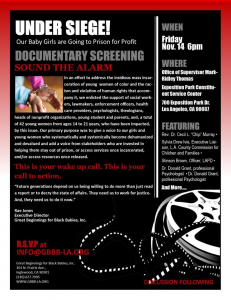Letter to Friends from Leslie Acoca, President and Founder
National Girls Health and Justice Institute.
October 11, 2014, the International Day of the Girl, led me to reflect on my last 3 years in Los Angeles serving as President of the National Girls Health and Justice Institute (NGHJI), and on my 15 years of work to end the incarceration of young girls in America by improving their access to medical care. Our work is hard because Americans just aren’t told that 429,000 girls aged 10-17 get arrested each year in America – mostly for running away from abusive homes – and that they get arrested younger and are medically sicker than boys. Americans just don’t know that many of these medically vulnerable children have never seen a doctor in their lives, or if they have, that they lose their health insurance at the point of being locked up just when they are most traumatized and need it most desperately.
Americans just aren’t told that removing community-based health insurance from incarcerated kids is massively shortsighted, given that our research shows that improving girls access to medical care decreases their recidivism – or the likelihood that they will ever get in trouble again – by 72%, while making them and their children healthy and strong. Due to complex Federal policies, incarcerated girls, and boys who lose or have their medical insurance removed or suspended as soon as they enter lock-ups, are the children most left behind and left out of Obamacare. Few know these facts.
We at the NGHJI are dedicated to creating a health care solution to the problem of incarceration, and to giving girls a healthy future. But we are pretty much the only organization in the country with a focus on improving health access for incarcerated girls – the sickest and most vulnerable adolescents in the country.
Awareness is dawning slowly among policymakers, but not fast enough for some girls, like one incarcerated girl we know who has a history of being trafficked, and who finds it too painful to sit in her schoolroom chair due to the sexual injuries she has suffered. Standard detention medical intake – because it was not designed for girls – did not identify her injuries at intake, so she remained untreated. The girl’s teachers thought she was lazy and resistant to learning when in fact she was in constant pain that she found difficult to talk about. The Girls Health Screen would have identified this girl’s sexual injuries and gotten her the treatment she needed.
Today, I’m looking back on our hard won successes, like getting our iPad-based Girls Health Screen – the only medical screen designed just for girls in the US – into the Stockton Detention Center in San Joaquin County, California, where close to 300 girls will take the GHS each year while locked up. We expect that all 2,000 girls entering detention in Los Angeles County next year will take the GHS. What this means going forward is that every girl in these detention centers will have her health needs routinely identified and treated.
I’m proud that the Girls Health Screen helped get emergency medical attention to a 15-year old girl behind bars who was experiencing two life-threatening medical conditions: a tubal pregnancy and a suicidal depression. But it’s disturbing that only two locked facilities – out of 2,800 locked child jails holding girls nationwide – are using the Girls Health Screen to save and improve vulnerable girls’ lives when thousands of girls could be helped and communities could be made safer. The Girls Health Screen, Girls Health Passport, and other tools are available, tested, and inexpensive to use. Why aren’t they being used? When I recently asked a community member that question, this person looked at me and said, “These girls just aren’t that important.”
I also think it’s because incarcerated girls are invisible and that invisibility, like a serious disease, is a life-threatening condition. I invite more parents of daughters, more politicians, more foundation leaders, and more sensitive media to come with us to meet our girls and hear their stories. Most are poor girls of color – primarily Latina in California – who are stigmatized by the violence they’ve experienced and their lack of education and health care. And yet, so many are so brave and smart. Our girls behind bars may never get a prize like Malala – who deserves all the recognition she is receiving and more – but our hidden girls are also beautiful, talented, outspoken, resourceful, brave, articulate young women.
I believe that every day should be the Day of the Girl. And among the photos of brave and oppressed girls from around the globe flashed on the web on the International Day of the Girl – the faces of OUR girls locked up right here in America should come out of obscurity and also be pictured. As one 14 year-old behind bars told me, her hands on her hips “We are not nothing!”









